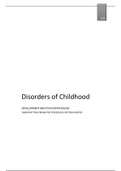2020
Disorders of Childhood
DEVELOPMENT AND PSYCHOPATHOLOGY
SAMENVATTING PREMASTER PEDOGISCHE WETENSCHAPPEN
,Inhoud
Chapter 1: Introduction........................................................................................................ 2
Chapter 2: Models of Child Development, Psychopathology, and Treatment ................................ 3
Chapter 3: Principles and Practices of Developmental Psychopathology ...................................... 6
Chapter 4: Classification, Assessment and Diagnoses, and Intervention ..................................... 9
Chapter 5: Disorders of Early Childhood ................................................................................ 12
Chapter 6: Intellectual Development Disorder and Learning Disorders ...................................... 17
Chapter 7: Autism Spectrum Disorder ................................................................................... 26
Chapter 8: Maltreatment and Trauma- and Stressor-Related Disorders ..................................... 32
Chapter 9: Attention Deficit/Hyperactivity Disorder ................................................................. 42
Chapter 10: Oppositional Defiant Disorder and Conduct Disorder.............................................. 45
Chapter 11: Anxiety Disorder, Obsessive-Compulsive Disorder, and Somatic Symptom Disorders. 54
Chapter 12: Depressive Disorders, Bipolar Disorders, and Suicidality ........................................ 61
Chapter 13: Eating Disorders ............................................................................................... 70
Chapter 14: Substance-Related Disorders and Transition to Adult Disorders. ............................. 75
1
,Chapter 1: Introduction
Developmental psychopathology → Intense, frequent, and persistent maladaptive
patterns (onaangepaste patronen) of emotion, cognition, and behaviour
considered within the context of normal development, resulting in the current and
potential impairment (stoornis/beperking) of infants, children, and adolescents.
(look at strengths and weaknesses as kids experience age-related challenges, zie
table hiernaast).
Common descriptions of normality and psychopathology often focus on statistical
deviance, sociocultural norms and mental health perspectives.
• Statistical deviance → Compared to the
distribution in a particular sample,
statistical deviance refers to the relative
infrequency of certain emotions,
cognitions and/or behaviours. How does
the child fit in.
• Sociocultural norms → The beliefs and expectations of certain groups
about what kinds of emotions, cognitions and/or behaviours are
undesirable or unacceptable.
• Mental health perspectives → mentally healthy children and adolescents
enjoy a positive quality of life; function well at home, in school and in
their communities; and are free of disabling symptoms of
psychopathology. (children who have negative quality of life, who function
poorly, or who exhibit certain kinds of symptoms might have a disorder).
Adequate adaptation has to do with what is considered okay, acceptable or good
enough. Optimal adaptation has to do with what is excellent, superior or ‘the best
of what is possible’.
Developmental epidemiology → frequencies and patterns of distributions of
disorders in infants, children and adolescents. Prevalence and incidence rates are
both measures of the frequency of psychopathology. Prevalence refers to the
proportion of a population with a disorder (all current cases of a type of disorder)
and incidence refers to the rate at which new cases arise.
Barriers to care → factors that impede access to mental health services, including
structural barriers such as lack of provider availability, inconveniently located
services, transportation difficulties, inability to pay, inadequate insurance
coverage, long waiting lists. Also there can be individual barriers a such as denial
of problems or lack of trust in the system; and sociocultural barriers such as the
stigma of psychopathology or mental illness.
Stigmatization → negative attitudes (such as blaming or overconcern with dangerousness),
emotions (such as shame, fear or pity), and behaviours (such as ridicule or isolation) related to
psychopathology and mental illness.
• Dimensions of stigma: Negative stereotypes, devaluation and discrimination
• Targets of stigma: The individual and the family
• Two contexts of stigma: The general public and the self/individual.
2
, Chapter 2: Models of Child Development, Psychopathology, and
Treatment
Models of development, psychopathology, and treatment allow us to organize our clinical
observations of children and our research into coherent, informative accounts.
Two ways models can function:
• Dimensional models of psychopathology → models that emphasize the ways in which
typical feelings, thoughts and behaviours gradually become serious problems, which then
may intensify and become clinical diagnosable disorders. (These models also are referred
to as quantitative and continuous, predictive of future behaviour patterns).
• Categorical models of psychopathology → models that emphasize discrete and qualitative
differences in individual patterns of emotion, cognitions, and behaviours. (The models also
are referred to as qualitative and discontinuous, not predictive of future behaviours
patterns).
Physiological models
Physiological models are models of psychopathology that emphasize biological processes, such as
genes and neurological systems, as being at the core of human experience; physiological models
explain the development of psychopathology, its course, and its treatment in term of biological
factors.
A lot of researchers are focused on the human connectome, the diagram of the brain’s neural
connections (complete kaart van de neurale verbindingen in de hersenen).
Thalamus → process and relay
information between cerebral
hemispheres.
Hypothalamus → basic urges.
Limbic system → emotion and
memory center
Cerebellum → movement and
cognitive processes
Frontal; thinking, Parietal;
integrating, senses, Occipital;
sight, Temporal; smell and sound
Neural plasticity, the ability of the brain to flexibly respond to physiological and environmental
challenges and insults.
Brain plasticity
and effortful
change over time
Genetics play a critical role in physiological models. We need to understand the many ways that
the genetic makeup of an individual (genotype, makeup of a cell) or influences the observable
characteristics of an individual (phenotype, expression of genetic makeup).
Researches:
• Molecular genetics, studies of the effects of specific genes at the DNA level.
• Behaviour genetics, the study of the joint effects of genes and environment, provides a
framework for understanding many sources of genetic influence and allows researchers to
estimate the heritability ( the proportion of phenotypic differences among individuals that
can be attributed to genetic differences in a particular population) of many physiological
characteristics.
3





